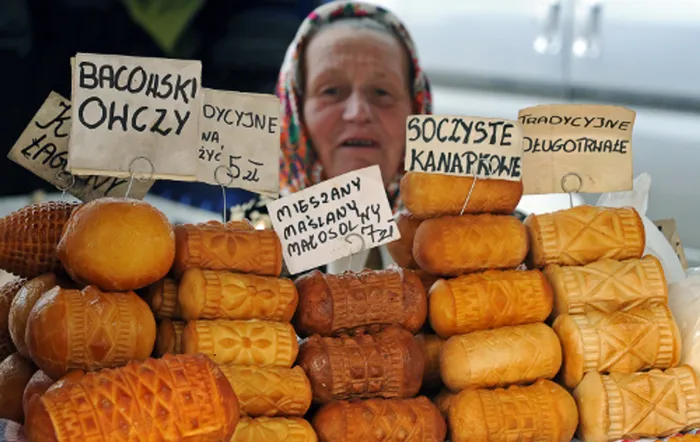Polish highlanders make cheese the old-fashioned way

By Maja Czarnecka
Kokoszkow, Poland - Sinking their bare hands into curdled milk and using only a campfire and rudimentary wooden tools, highlanders from Poland's Tatra mountains still make 'Oscypek', their famous sheep's cheese, just as their ancestors did centuries ago.
Sitting by an open fire in a spartan shepherd's hut tucked away in a mountain meadow, Jacek Wolski turns a roll of cheese in his powerful hands to make Oscypek in his people's time-honoured tradition.
Springtime sees Poland's "gorale", or highlanders, take their sheep to pasture in the Tatra mountain meadows. Local Catholic priests bless the flocks as they leave for their summer pastures as entire highlander families turn up for the traditional ceremonies dressed in colourful folk costumes.
"Oscypek is entirely handmade, using only wooden tools," Jacek explains.
"The authorities tried to make us install tiled surfaces in our huts and use only the kind of stainless steel utensils found in industrial-scale dairies," Jacek says defiantly.
"Utter nonsense!," exclaims the 'baca' (pronounced batsa), as the 120 or so local elite cheesemaker-shepherds are known in the local Tatra highlander dialect.
"Without the bacteria found in the shepherd's huts, Oscypek would lose its unique taste," says Jan Janczy, director of the association of goat and sheep farmers based in Nowy Targ, southern Poland.
A year ago, Oscypek obtained the EU's Protected Designation of Origin status, guaranteeing local producers the right to make it using traditional methods.
"If we would not have registered it, the production of Oscypek using the traditional recipe would have completely disappeared," Janczy explains.
Without the special status, stringent EU hygiene standards for food production could have spelled the end of traditional Oscypek production.
Slovakia's 'Ostiepok' cheese, produced across the border on the southern side of the Tatra mountains, also received the EU's Protected Designation of Origin status.
A gleaming new Land Rover stands in front of the little mountain hut, which has neither running water nor electricity - a solitary sign of modernity.
Jacek no longer spends the entire summer with his flock as his father did decades ago. Instead, he drives to the hut every afternoon from town to make cheese.
Jacek's troop of hired shepherds, or "juhas" stay night and day on the mountain meadows with his herd of 700 sheep, several cows and goats.
Milk from the early morning milking curdles by the time Jacek arrives at the hut. He rolls it into balls and dips it into boiling water for a few seconds and then squeezes it with his bare hands to remove any excess liquid.
The cheese is then patted into special wooden forms that give it a traditional cylindrical form.
Each baca carves his own set of designs typical of the region into the wooden forms, which are then impressed around the circumference of each tapered cylinder of Oscypek. The milk thistle pattern is the most common.
Prepared in this way, Oscypek is soaked in salt water for 24-hours and then placed to smoke under the roof in the same hut where it is prepared and where an open campfire is kept burning through the night to warm sleeping shepherds.
"Oscypek can only be produced using raw (unpasteurised) sheep's milk and we can add cow or goat's milk so long as it does not account for more that 40 percent of the total," Janczy explains.
"In Zakopane, Poland's most popular winter resort, dishonest traders sell tourists (counterfeit) Oscypek made from cow's milk. But sheep that are pregnant don't produce milk during the winter," he says.
To promote real Oscypek, Zakopane's tourism bureau has created a special tour allowing visitors to find the mountain meadow huts of 25 baca cheesemakers. - Sapa-AFP